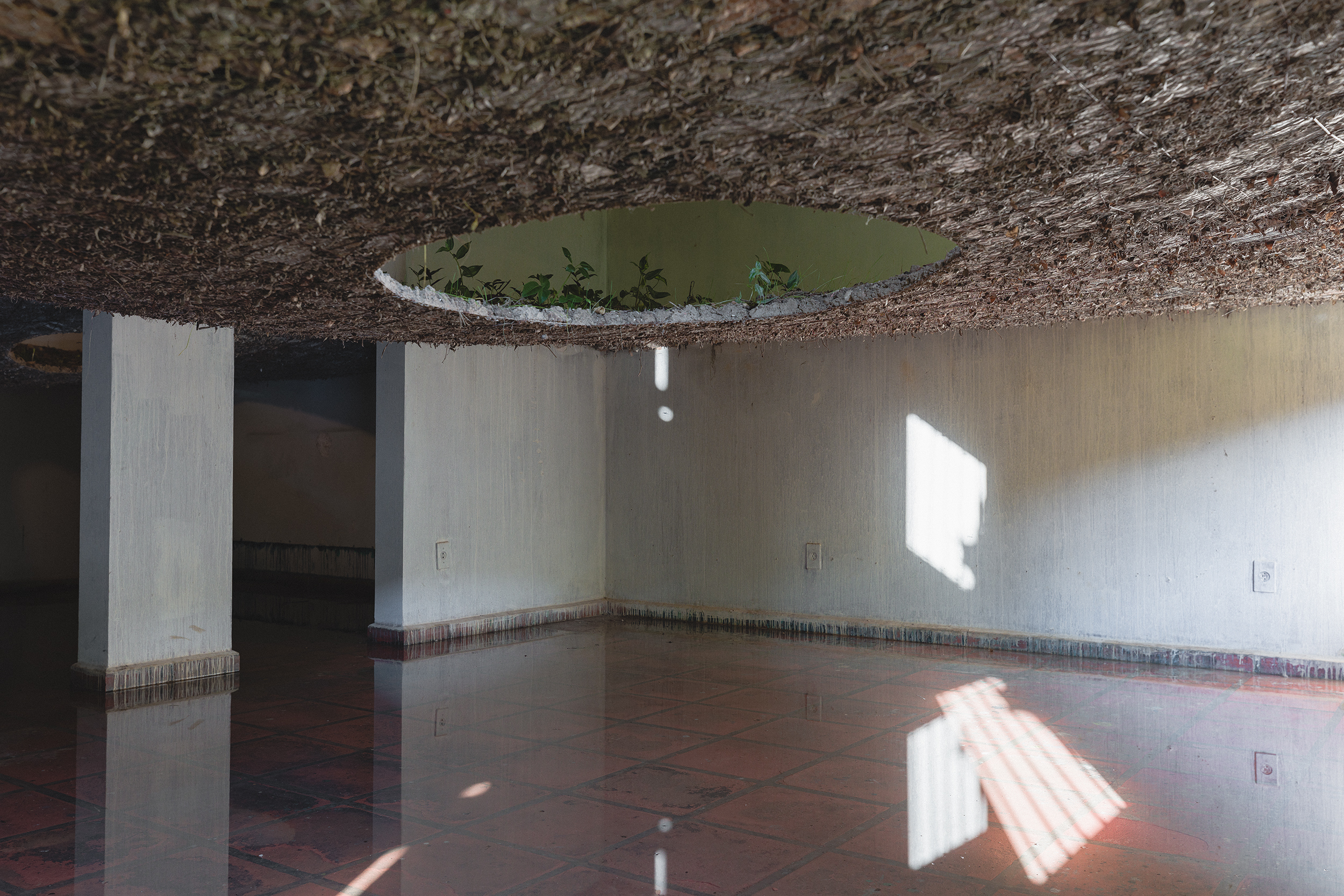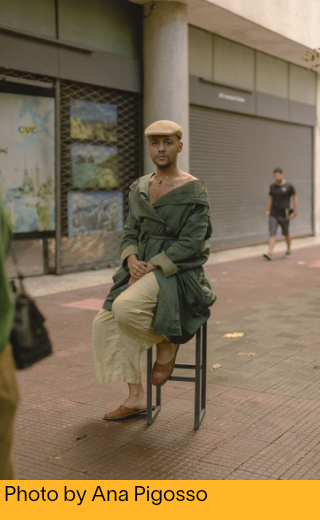"Before Sinking, it Floats", 2021
January 2022
Guilherme Teixeira

Plant growth / Installation view May 2021
January 2022
Guilherme Teixeira
After a riffle shuffle, the cards cascade (or how we assist abandonments)
SIDENOTE: C. L. Salvaro’s studio/living space is an old house in the Jardins neighbourhood of São Paulo, where, alongside several images of the works presented at Liste, he has assembled a living installation. What may sound quite descriptive in the text that follows echoes Salvaro’s own work and its capacity to exist within an environment while questioning how a contemporary practice can unfold through, and with, the responsibilities of the space towards matter.
Apart from the suspended installation, and a few other works that inherit the environment of the house itself, the text also focuses on a specific body of works comprising materials found at construction sites and during walks in places ranging from Belo Horizonte to São Paulo, from Buenos Aires to Seoul. The objects – bricks, carpets, playing cards – are used in the execution of wall pieces that present themselves like sentences in a conversation. By bringing together these fragments, Salvaro’s practice questions the possibilities that arise when, despite the abandonment of signs and language, a text can still exist, unhurried, through its intention.
There’s a lot to be said about water, time and geometry’s intention towards space’s surfaces here, yet the sky is but clouds and grey when I arrive at Salvaro’s home studio. The early-20th-century house rises from behind the gate, its walls and presence only speaking of our inability to acknowledge nature’s way of reclaiming space. Once within these walls, it’s clear that something is prepared to deliver a secret that sends shivers up my spine as I face what there’s to be said about water, time and geometry’s intention.
Inside the house, a formative desire cinches history and, from its wall's axis, a grid of steel, earth, three species of plants and time enunciate another shape: that of how a body is to be under the installation’s load. A bent figure is only able to stand tall at the few circular openings – cracks in a geometric structure where surface and line coexist. Today, approximately one year after its assembly, the structure collapses, subject to gravity's demands.
For a long time, I believed the idea of gravity was not fair regarding its encounters with the exterior of spaces, the autonomy of matter or its rushing towards the ground. Yet, here, the way Salvaro’s works coexist within a task of suspension makes me question whether these premises were valid. There’s an equation that delves into the dilation of time that, within this house’s walls, makes me wonder how Salvaro faces the chronology of the works that have inhabited the architecture. Taking as a starting point their own agencies – and how time also slides through the artist’s hand – the works are willing to acknowledge gesture and their inherent ability to fraction time, as well as an idea of a past which only the inherent chronology of the works can grasp “In this manner, the totality defines a relationship of radical and absolute interiority, which nullifies any distinction between container and contained. Because, if everything is everything, not only does each thing contain all other things, but a thing has to find itself within no matter what other thing—what is more, in the things it contains. The fact of ‘being contained in something’ coexists with the fact of containing this same thing. The container is also the content of what it contains. This identity is not logical, it is topological and dynamic. Every object is a site for every other object and, conversely, to be a place is to find one’s world in every other thing. In a certain sense, any thing is a world—where the world is no longer the ultimate, unreachable horizon given only at the end of time and at the farthest extension of space, but the intentional identity with any of its objects.” – Emanuele Coccia, “The life of plants: a metaphysics of mixture”, Polity Press, 2019, pp. 71–71.
A specific room that stands out is one where the artist subjects a series of objects to a musty environment, where mould is in the process of taking over wood, papers and a lamp. Standing together, Salvaro and I start to wonder: Is the action of the mould a negotiation with the space that the papers, wood, debris and cards now inhabit, or is it a way of assuming the existence of something that has always been within them? If there’s an authority here, where does it come from?
Do you know what a riffle shuffle is? It’s when images on playing cards are obliged to face each other. During my most recent discussion with Salvaro regarding his work, the idea that there are two concepts of time operating within this context brought to our attention the subtle relation that the “time” culture demands is but the will from both artist and environment to create a being that wouldn’t search the ground but rather face a place where autonomy makes its way through gravity, through space. The old house inhabited by Salvaro’s works is, in a way, obliged to face how time and culture work within it, and how it will be the one responsible for everything that happens to the works inside it; it understands its role in affecting the “being” those objects demand.
There’s a lot to be said about the autonomy of matter, ideas of rediscovery and relations with authority here: What are the tasks of an object’s history today? What do Salvaro’s works agree upon when it comes to relations between their own agencies? What are their responsibilities towards this “task of suspension”?
Something floats in this environment, takes up all the rooms, descends from each and every wall, graces the plants, houses the birds and the fungi, points toward the future of our species using its own ruin and debris as surface, ignores our attempts of maintenance, attaches itself to our lungs and our hair, whispers old tales of domestic existence into our ears, ignores the way we manipulate matter – or at least the way we believe we do. It looks deep into our ways, negotiates how our bodies inhabit it, defaces any attempt of representation, shouts to us in a silent language that there’s much to be said about water, time, and geometry’s intention towards surface and space. And yet, there’s nothing our species can do to minimise the inherent bluntness with which this environment reclaims every regulatory quest we perform by only allowing us the potential of a false desire for it. An everlasting task of reclamation.
There is much to be said about matter and our desires for the places our species inhabits. Yet here we are, crawling on the ground, hoping that its will of reclamation is gentle towards any movement we make in our attempt to seize it. Suspended, we acknowledge there is much to be said.

Guilherme Teixeira (b. 1992, São Paulo, Brazil) is a writer, curator and editor. In his research, he addresses enunciations and other names that things demand today. Among the institutions he has worked with are CCSP, Video_Brasil and Pro Helvetia, as well as galleries and art consulting offices. Among his curatorial projects are “PAREDÃO” (CCSP), “Yesterday Was A Long Day” (MARP), “O Grande Susto” (SPACE), “Continuous Noise and Absence” and “A Imensa Preguiça” (both at Sancovsky Gallery), and “Notes on some dysfunctionality” (Homeostasis.Lab). Teixeira is also editor of the periodical O TURVO and curator and editor of the “expresso” project, which was created with the São Paulo Department of Justice and Fundação Casa (Socio-Education Service Centre for Minors) and presents artistic processes to young minors who have been inside the system of the Fundação Casa.